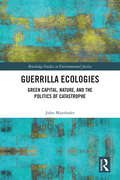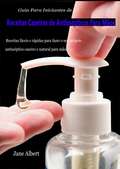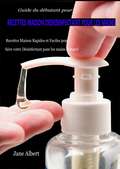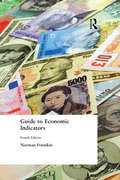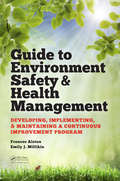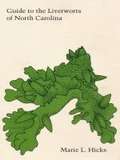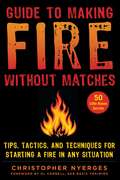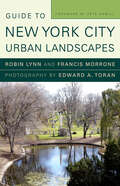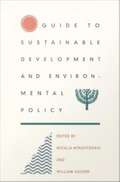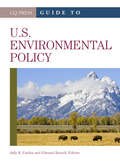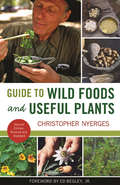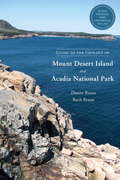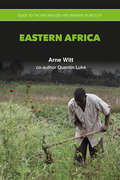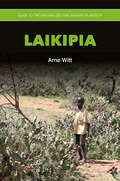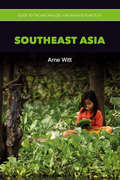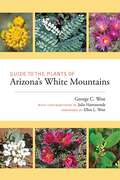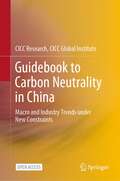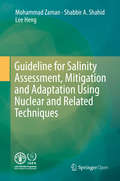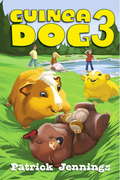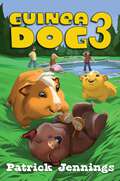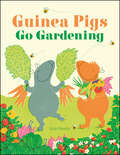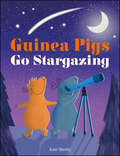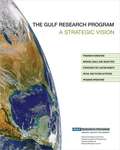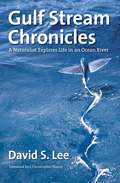- Table View
- List View
Guerrilla Ecologies: Green Capital, Nature, and the Politics of Catastrophe (Routledge Studies in Environmental Justice)
by John MaerhoferThis book intervenes in contemporary debates about climate activism, militancy, and strategy that have been gathering force in radical ecological circles. It responds to some of the urgent questions about utilizing militancy as part of the overall effort to foster an ecosocialist society. Building upon the crucial work of scholars and activists from the 1970s to the present, such as Carolyn Merchant, Ursula Heise, Raj Patel, Joan Martinez Alier, Neil Smith, and Mark Dowie, this book discusses and regenerates key principles of guerrilla ecology. It presents a significant critique of green capital and its impact on the shape of environmental and climate justice movements. From car manufacturers dedicating profits to reforestation, to big oil conglomerates funneling money into universities that are developing techno-fixes which may stave off ecological disaster, green capital has become the mainstay of contemporary cultural, political, and economic reproduction – aiming to fuse profitability and sustainability. The book brings together discussion on key topics in a range of contexts including biopiracy and biocolonialism, indigenous resistance, extractivism, anti-imperialism, ecotage, and eco-militancy. It will attract scholarly readers from diverse spaces in the environmental humanities, environmental and climate justice, radical ecology, and philosophy.
Guia Para Iniciantes de Receitas Caseiras de Antissépticos Para Mãos: Receitas fáceis e rápidas para fazer o seu próprio antisséptico caseiro e natural para mãos
by Jane AlbertO antisséptico para mãos comprado em lojas está ficando caro e, com a escassez dos higienizadores para mãos devido ao COVID-19, você pode ter que recorrer à fazer o seu próprio antisséptico. Fazer o seu próprio antisséptico para mãos é um processo simples que resulta em uma fórmula que você pode personalizar para adequá-la ao seu gosto pessoal. O CCD recomenda lavar as mãos várias vezes ao dia durante pelo menos 20 segundos, mas a realidade da rotina diária pode as vezes ser um empecilho (estar sempre em atividade, estar em um avião, trem ou metrô, você consegue compreender) — e é nesse momento que um antisséptico para mãos torna-se necessário. Ao tempo em que existem várias versões sem álcool de antissépticos para mãos no mercado, o CCD recomenda um antisséptico que contenha pelo menos 60% de álcool, para obter máxima eficácia — sem contar que todos estão esgotados nos estabelecimentos locais (pelo menos em Los Angeles) ou estão custando de 10 a 20 vezes o preço normal. Alguns dos antissépticos para mãos comercializados contêm ingredientes tão assustadores quanto os germes dos quais eles protegem, então por que não fazer o seu próprio antisséptico para mãos a partir dos ingredientes que você puder escolher, em apenas alguns fáceis passos. Aqui está uma prévia do que você aprenderá: • Preocupações de segurança dos antissépticos para mãos • Eficácia dos antissépticos para mãos • Várias receitas caseiras de antissépticos para mãos • Receita da Organização Mundial da Saúde (OMS) para fazer antissépticos para mãos à base de álcool • Como fazer gel de aloe vera • Técnica correta de lavagem das mãos • Dicas sobre como usar o antisséptico para mãos de forma eficiente • E muito mais! Role para cima e clique no botão "Compre agora com 1 clique" para obter sua cópia agora!
Guide du débutant pour RECETTES FAIT MAISON DE DESINFECTANT POUR LES MAINS: Recettes Rapides et Faciles pour faire votre Désinfectant Naturel pour les mains fait maison
by Petcha JulietteLe désinfectant commercial pour les mains devient cher, et avec la pénurie de désinfectant pour les mains due au COVID-19, vous devrez peut-être recourir à la fabrication du vôtre. La fabrication de votre propre désinfectant pour les mains est un processus simple qui se traduit par une formule que vous pouvez personnaliser en fonction de vos goûts personnels. Le CDC recommande de se laver les mains pendant au moins 20 secondes plusieurs fois par jour, mais la réalité de la vie peut vous gêner (en déplacement, en avion, en train ou en métro, vous avez l'argument) - et c'est à ce moment qu'un désinfectant pour les mains est nécessaire. Bien qu'il existe plusieurs versions sans alcool de désinfectants pour les mains sur le marché, le CDC en recommande une qui contient au moins 60% d'alcool pour une efficacité maximale - et tous ces produits sont soit vendus chez des détaillants locaux (au moins à Los Angeles), soit 10-20 fois leur prix normal. Certains désinfectants pour les mains commerciaux contiennent des ingrédients aussi effrayants que les germes dont ils vous protègent, alors pourquoi ne pas fabriquer votre propre désinfectant pour les mains à partir d'ingrédients que vous sélectionnez en quelques étapes faciles. Voici un aperçu de ce que vous apprendrez: Préoccupations liées à la Sécurité des Désinfectants pour les mains -Efficacité des désinfectants pour les mains -Diverses recettes maison de désinfectant pour les mains -Recette de l'Organisation Mondiale de la Santé (OMS) pour créer un désinfectant pour les mains à base d'alcool -Comment faire du gel d'aloe vera -Technique correcte de lavage des mains -Conseils pour utiliser plus efficacement le désinfectant pour les mains Et bien plus!
Guide to Economic Indicators
by Norman FrumkinNow revised and expanded, this widely-used desk reference provides quick and easy access to current and reliable data on the major statistical measures of the U.S. economy. Equally useful for students, general readers, economists, analysts, journalists, and investors, the guide provides concise, jargon-free explanations of the meaning, use, and availability of more than 70 macroeconomic indicators, including websites, recent trends, and current data.
Guide to Environment Safety and Health Management: Developing, Implementing, and Maintaining a Continuous Improvement Program (Systems Innovation Book Series)
by Frances Alston Emily J. MillikinDevelopment and execution of a successful ES&H program in today's profit-driven business climate is challenging and complex. The techniques outlined in this book provide guidance and aid in understanding the challenges that must be addressed by ES&H management and professionals. This book covers the primary areas of ES&H and key elements that should be considered in developing, managing, and implementing an effective, compliant and cost effective program. It to fulfills the need that exists in the workplace for guidance from a practical experience view point.
Guide to Liverworts of North Carolina
by Marie L. HicksNorth Carolina is home to 66 genera and 195 species of liverworts--small, mosslike plants occupying moist microhabitats that form an inconspicuous part of the vegetation. Marie L. Hicks' Guide to the Liverworts of North Carolina provides the first complete field guide to the hepatic flora in North Carolina. The volume offers a key to genera, species descriptions, distribution maps, a glossary, and 120 original drawings of liverworts as they appear in North Carolina. North Carolina's varied physiography creates a diversity of flora, ranging from boreal plants in the mountains to subtropical plants in the coastal plain. Collections of hepatics in North Carolina have been sporadic over the years, and knowledge of their distribution within the state has accumulated gradually. Guide to the Liverworts of North Carolina builds on earlier field studies, including those of Hugo L. Blomquist and R. M. Schuster, to provide keys and illustrations to aid identification. This important, comprehensive field guide will also be useful in states adjoining North Carolina and is designed for students, botanists, and all those interested in identifying local liverworts.
Guide to Making Fire without Matches: Tips, Tactics, and Techniques for Starting a Fire in Any Situation
by Christopher NyergesLearn How to Start a Fire, Even When It Seems Impossible! Since the dawn of mankind, fire has been a staple of survival. Whether it is used to keep warm, cook food, or scare away predators, fire is an essential element, one that is almost impossible for humans to live without. But with society's current dependence on modern tools and technology, many persons would have no idea how to start a fire without matches or a lighter. In an emergency situation, that lack of knowledge could easily prove fatal. In Guide to Making Fire without Matches, survival expert Christopher Nyerges provides readers with all the skills that they may need to start a fire without modern tools. The book begins by covering the history and lore surrounding fire, and then moves on to describe, in detail, the four main methods through which fire is made: friction, the sun, electricity, and chemistry. Additional topics include: How to make a fire in the rainThe best locations to build a fireSafety precautions to take when around fireHow to tend your fireHow to make a signal fireDifferent ways to cook with fireAnd much more! With helpful diagrams, illustrations, and sidebars, Guide to Making Fire without Matches is the ultimate reference book for learning about an essential element.
Guide to New York City Urban Landscapes
by Francis Morrone Robin LynnA tour of not-to-be-missed public places—parks, plazas, memorials, streets—that shape the New York experience. The thirty-eight urban gems covered here range from newly created linear spaces along the water’s edge, such as Brooklyn Bridge Park and the East River Waterfront Esplanade, to revitalized squares and circles, such as those at Gansevoort Plaza in the Meatpacking District and Columbus Circle, to repurposed open spaces like the freight tracks, now the High Line, and Concrete Plant Park in the Bronx. Readers can discover midtown atriums, mingle with the crowds in Union Square, travel offshore to nearby Governors Island, and enjoy the vistas of historic Green-Wood Cemetery. Pete Hamill writes in his foreword, “I’ve . . . made a list of new places I must visit while there is time. With any luck at all, I’ll see all of them. I hope you, the reader, can find the time too.” Concise descriptions, helpful maps, and vivid photographs capture the New York urban scene.
Guide to Prehistoric Ruins of the Southwest (2nd Edition)
by Norman T. OppeltA new edition of a popular guide to the major ruins of Utah, Colorado, Arizona, and New Mexico, the range of Anasazi, Hohokam, and Mogollon cultures.
Guide to Sustainable Development and Environmental Policy
by Natalia Mirovitskaya William AscherThe Guide to Sustainable Development and Environmental Policy is a comprehensive presentation of definitions, philosophies, policies, models, and analyses of global environmental and developmental issues. With a wealth of comparative, multidisciplinary, and geographically varied perspectives on environmental governance, it also provides detailed and balanced discussions about specific environmental issues. The guide combines formal, objective entries with critical commentaries that emphasize different opinions and controversies. With succinct explanations of more than a thousand terms, thoughtful interpretations by international experts, and helpful cross-referencing, this resource is designed to serve as a roadmap for understanding the issues and debates in the overlapping fields of environment and development. Intended for use by activists, journalists, policymakers, students, scholars, and interested citizens, the Guide to Sustainable Development and Environmental Policy will be a helpful tool for anyone trying to get a comprehensive look at the many environmental organizations, schools of thought, development programs, international environmental treaties, conventions, and strategies that have proliferated in the past few decades.
Guide to U.S. Environmental Policy
by Edmund Russell Sally K FairfaxGuide to U.S. Environmental Policy provides the analytical connections showing readers how issues and actions are translated into public policies and persistent institutions for resolving or managing environmental conflict in the U.S. The guide highlights a complex decision-making cycle that requires the cooperation of government, business, and an informed citizenry to achieve a comprehensive approach to environmental protection. The book’s topical, operational, and relational essays address development of U.S. environmental policies, the federal agencies and public and private organizations that frame and administer environmental policies, and the challenges of balancing conservation and preservation against economic development, the ongoing debates related to turning environmental concerns into environmental management, and the role of the U.S. in international organizations that facilitate global environmental governance. Key Features: 30 essays by leading conservationists and scholars in the field investigate the fundamental political, social, and economic processes and forces driving policy decisions about the protection and future of the environment. Essential themes traced through the chapters include natural resource allocation and preservation, human health, rights of indigenous peoples, benefits of recycling, economic and other policy areas impacted by responses to green concerns, international cooperation, and immediate and long-term costs associated with environmental policy. The essays explore the impact made by key environmental policymakers, presidents, and politicians, as well as the topical issues that have influenced U.S. environmental public policy from the colonial period to the present day. A summary of regulatory agencies for environmental policy, a selected bibliography, and a thorough index are included. This must-have reference for political science and public policy students who seek to understand the forces that U.S. environmental policy is suitable for academic, public, high school, government, and professional libraries.
Guide to Wild Foods and Useful Plants
by Ed Begley Jr. Christopher NyergesAn array of abundant wild foods is available to hikers, campers, foragers, or anyone interested in living closer to the earth. Written by a leading expert on wild foods and a well-known teacher of survival skills, Guide to Wild Foods and Useful Plants is more than a listing of plant types--it teaches how to recognize edible plants and where to find them, their medicinal and nutritional properties, and their growing cycles. This new edition features more than 70 plants found all around the United States along with more than 100 full-color photos plus a handy leaf key to help readers identify the plants. It also includes fascinating folklore about plants, personal anecdotes about trips and meals, and simple and tasty recipes.
Guide to the Geology of Mount Desert Island and Acadia National Park
by Sarah Hall Duane Braun Ruth BraunThis richly-illustrated, full-color guide to the geology of Mount Desert Island, Maine, the home of Acadia National Park, makes the spectacular scenery and rich geological history accessible to outdoor explorers, geology enthusiasts, and armchair travelers alike. The Guide grounds readers in basic geologic concepts before chronicling the unique history of the area from 550 million years ago to the present. Including information-packed self-guided trips with stops at 31 points of interest, this book is lavishly illustrated with 100 full color photos, maps, and illustrations that enhance appreciation of this national treasure.Duane and Ruth Braun relate the fascinating story of the region's formation, explaining how a slice of South America with Mount Desert Island bordering its southern side landed on the edge of North America to form Maine. Another piece of South America collided with this landing, causing Mount Desert Island to erupt violently in a ten mile wide volcanic caldera. The Island then underwent a long period of stream erosion culminating in a period of glacial erosion to form the present landscape. The exceptional scenery that resulted has attracted visitors from around the world. This book unlocks the many secrets of the formations, offering a deeper understanding of the land and its origins.
Guide to the Naturalized and Invasive Plants of Eastern Africa
by Arne WittBoth in Ethiopia and in the countries of East Africa, the continuing proliferation and spread of invasive alien species (IAS) is now recognized as a serious problem, which needs to be addressed. While this situation has improved dramatically over the past 10 years, further progress has been hampered by the absence, hitherto, of a comprehensive IAS database for the region. Countries in the region have repeatedly expressed the need for such a database, as a tool to assist in the identification of naturalized and invasive alien plant species, and in understanding their impacts, both existing and potential, while also providing pointers on what can be done to manage such species. This information is seen as essential, not only in enabling countries to develop effective IAS management strategies, but also in helping them to meet their obligations under various international agreements and treaties, including Article 8 (h) of the Convention on Biological Diversity (CBD) and Target 9 of the 2020 Aichi Biodiversity Targets. In providing such a database, this Guide is intended to give the countries of eastern Africa the information they require, in order to be able to develop effective strategies for combating the growing menace posed by invasive alien plants. It is further hoped that this Guide will foster increased regional collaboration, in responding to the challenges of managing shared invasive plant species. The Guide is based on the findings of extensive roadside surveys, carried out throughout the region, and on a review of the literature pertaining to naturalization and/or invasiveness among alien plants in eastern Africa. By this means, scores of exotic plant species were found to have escaped from cultivation, and to have established populations in the 'wild', to the detriment of natural resources and the millions of people in the region who depend on these resources. Included in the Guide are descriptions of roughly 200 exotic plant species which are either invasive already or which are deemed to have the potential to become invasive in the region. The profiled species include aquatic invasive plants or waterweeds (seven species); vines, creepers or climbers (20 species); terrestrial herbs, shrubs, and succulents (more than 30 species of each), and trees (more than 60 species). Also profiled in this Guide are many exotic plant species which, although their current distribution in the region may still be relatively localized, nevertheless have the potential to become considerably more widespread and problematic. The wide range of habitats and climatic conditions found within Ethiopia and across East Africa make the region as a whole particularly prone to invasions by a host of introduced plant species. Such invasions are being facilitated by increased land degradation, especially through overgrazing and deforestation, and also by climate change.
Guide to the Naturalized and Invasive Plants of Laikipia
by Arne WittThe impetus for the development of this Field Guide came about as a result of pleas from the community around the village of Doldol, Laikipia County, to initiate a control programme for Australian prickly pear [Opuntia stricta (Haw.) Haw.; Fabaceae], an invasive plant which was having a dramatic impact on livelihoods. However, a number of other exotic plants, which were less widespread, but had the potential of becoming invasive, were not seen as a potential problem. In order to avoid a similar situation from arising in the future, the community expressed a need for a Field Guide, which would include descriptions of naturalized and invasive species already present in, and those that were most likely to invade Laikipia County and, information on how best to manage them. An additional impetus was to contribute to the four main objectives of the National Strategy and Action Plan for the Management of Invasive Species in Kenya's Protected Areas. The Field Guide contributes in some or other way to all of these objectives which are to (i) Enhance awareness of invasive species to relevant actors; (ii) Prevent new invasions, manage established invasions and rehabilitate degraded habitats; (iii) Enhance research, monitoring and information management on invasive species; and (iv) Enhance capacity, resource mobilization and coordination. Extensive surveys revealed the presence of a number of introduced plant species which had escaped cultivation and established populations in the 'wild' to the detriment of natural resources and the people that depend on them. Introduced succulents, especially those in the genus Opuntia (Cactaceae), were found to be the most widespread and abundant invasive species in the semi-arid regions in the north and east of Laikipia County. Other succulents, those in the genus Bryophyllum (Crassulaceae), were also found to have escaped cultivation and were locally abundant. In the higher rainfall areas to the west and southwest, introduced trees such as black wattle (Acacia mearnsii De Wild.; Fabaceae) and Australian blackwood (Acacia melanoxylon R. Br.; Fabaceae) and the shrubs/climbers, Mauritius thorn [Caesalpinia decapetala (Roth) Alston; Fabaceae] and yellow cestrum (Cestrum aurantiacum Lindl.; Solanaceae), were invasive. Introduced plants, which have the potential to become problematic in Laikipia, unless eradicated or controlled, have also been included in the Guide. This includes species such as famine weed (Parthenium hysterophorus L.; Asteraceae) and 'mathenge' [Prosopis juliflora (Sw.) DC.; Fabaceae], which are already abundant in areas adjoining the County.
Guide to the Naturalized and Invasive Plants of Southeast Asia
by Arne WittDespite the significant impacts of alien plant species (IAS), there has not been a concerted effort to tackle the problem across the region. This can mainly be ascribed to a lack of policy, little awareness and limited capacity at a national and regional level. The UN Environment-Global Environment Facility project, 'Removing Barriers to Invasive Species Management in Production and Protection Forests in SE Asia', which was active in Cambodia, Indonesia, the Philippines and Vietnam, identified these barriers and produced this Guide which will go a long way to creating awareness about invasive plants, their impacts and how best to manage them. This Guide will serve as an invaluable aid in the identification, mapping, monitoring, and management of IAS that are already present in ASEAN member states, or which may become problematic in the future, due to increased trade and travel, economic development and climate change. It is hoped that this Guide would trigger similar efforts in other countries in Southeast Asia as the region moves toward socio-economic integration.
Guide to the Plants of Arizona's White Mountains
by George C. WestGeorge C. West provides a simple and quick guide written especially for amateur plant lovers, nature enthusiasts, interested hikers, tourists, and botanists who want to learn more about the plants of the White Mountains in east-central Arizona. The book is neatly organized into three parts, which include woody trees; all other annual, biennial, and perennial flowers, shrubs, and vines; and ferns.This useful guide is written in accessible language that makes it easy to identify over five hundred plant species found in the region. More than a thousand incredible color photographs of flowers, leaves, and other features provide nuanced detail that helps the reader differentiate various species of flowering plants, trees, and ferns. Guide to the Plants of Arizona&’s White Mountains is a must-have reference for all outdoor enthusiasts exploring this popular region of the Southwest.
Guidebook to Carbon Neutrality in China: Macro and Industry Trends under New Constraints
by CICC Research, CICC Global InstituteThis Open Access publication focuses on China’s goal of achieving peak carbon emissions in 2030 and carbon neutrality by 2060. The book is the first to systematically build a framework combining a top-down and bottom-up analysis of this acute topic.What does carbon neutrality mean for economics in China? Might it imply stagflation or is it an opportunity to maximize the potential of green manufacturing?The book offers a comprehensive analysis of how the pursuit of carbon neutrality may influence the development of China's economy, and the country's biggest industries, while foreseeing the likely changes in people's lifestyles.In total, the book constructs a comprehensive path for China's carbon neutrality drive from the perspective of the green premium. This effort lays the foundation for a discussion of the country's emissions reduction plan.The book goes further, calculating the investment required for different sectors to achieve carbon neutrality, and illustrating the roles of carbon pricing and green finance in this undertaking.The book’s information comes from a network of primary sources, including experts in the field and noted academics, to depict potential low-carbon roadmaps and green transitions in major industries.Emphasized is green development in sectors that will be critical to civilization, including in technology, energy, manufacturing, transportation, and urban planning, which are backed by in-depth discussions and analyses.Accessible and academically rigorous, the work is anchored in the economics of carbon neutrality, extends to potential policy implications and identifies investment opportunities.This valuable reference will attract readers interested in public policy, economics, finance, and investors who seek to better understand China's prospects in the low-carbon economy of the near future.
Guideline for Salinity Assessment, Mitigation and Adaptation Using Nuclear and Related Techniques
by Shabbir A. Shahid Lee Heng Mohammad ZamanThis open access book is an outcome of the collaboration between the Soil and Water Management & Crop Nutrition Section, Joint FAO/IAEA Division of Nuclear Techniques in Food and Agriculture, Department of Nuclear Sciences and Applications, International Atomic Energy Agency (IAEA), Vienna, Austria, and Dr. Shabbir A Shahid, Senior Salinity Management Expert, Freelancer based in United Arab Emirates.The objective of this book is to develop protocols for salinity and sodicity assessment and develop mitigation and adaptation measures to use saline and sodic soils sustainably. The focus is on important issues related to salinity and sodicity and to describe these in an easy and user friendly way. The information has been compiled from the latest published literature and from the authors’ publications specific to the subject matter. The book consists of six chapters. Chapter 1 introduces the terms salinity and sodicity and describes various salinity classification systems commonly used around the world. Chapter 2 reviews global distribution of salinization and socioeconomic aspects related to salinity and crop production. Chapters 3 covers comprehensively salinity and sodicity adaptation and mitigation options including physical, chemical, hydrological and biological methods. Chapter 4 discusses the efforts that have been made to demonstrate the development of soil salinity zones under different irrigation systems. Chapter 5 discusses the quality of irrigation water, boron toxicity and relative tolerance to boron, the effects of chlorides on crops. Chapter 6 introduces the role of nuclear techniques in saline agriculture.
Guinea Dog 3
by Patrick JenningsAn award-winning, hilariously funny middle-grade series about guinea pigs who act like other pets will move its author, Patrick Jennings, into the ranks of much-loved writers, such as Louis Sachar and Andrew Clements.When Rufus, Murphy, Lurena, and their pets go camping, they meet Pedro, a shy boy who seems afraid of just about everything--especially the water. One thing leads to another and the kids go into a nearby town to buy him a pet to cheer him up--a guinea pig, naturally. Yet what they bring home may look like a guinea pig, but it can swim--like an otter!Guinea Dog has appeared not only on many state lists, but on county and school district lists as well. Here are just some of its appearances: Hawaii NeNe Award Nominee, Washington State Sasquatch Award Nominee, Massachusetts Children's Book Award Honor, Florida Sunshine State Master List, Kansas Winner of the William Allen White Award, Colorado Children's Book Award Nominee, New Hampshire Great Stone Face Award Master List, and Texas's Cy-Fair Horned Toad Tales List."Short, manageable chapters; a breezy, conversational style; and indentifiable characters...make this a good choice."--Booklist"Early-chapter book readers will enjoy..."--School Library Journal"The writing is strong, the characters are a lot of fun, and the story just plain enjoyable ...There's a little something everyone can enjoy in this last Jennings number."--Betsy Bird, Fuse8Patrick's website is patrickjennings.com, or you may follow him on Twiitter @pjenningswrites.
Guinea Dog 3 (Guinea Dog #3)
by Patrick JenningsNo one could love camping more than Rufus. He and his best friend, Murphy, and their families and pets, including Fido, Rufus's famous guinea pig that acts like a dog, are planning to camp by a beautiful lake and relax and have fun. Then his mom announces that, without telling him, she has invited two kids who drive him totally crazy. Lurena brags that she is an expert on all things guinea pig. Dmitri wants Fido for his own pet—and Murphy for his best friend. This vacation is turning into a bust! Yet help is not far away. Another camper, Pedro, might prove to be an ally against Dmitri and his plots. Even better, a shirt drive from the campsite, a mysterious pet shop appears out of nowhere: Petopia. Pick up the latest installment of this award-winning, hilariously funny middle-grade series!
Guinea Pigs Go Gardening (The Guinea Pigs)
by Kate SheehyIntroduce your little one to Bob and Ginger, two adorable guinea pigs who love the outdoors, fresh produce, and - most of all - gardening!Bob and Ginger will show little ones how to grow fruit and vegetables in this sweet children&’s book. It&’s perfect for encouraging children aged 3-5 years to spend more time in the garden.Visit Bob and Ginger in their beautiful garden filled with vibrant red strawberries, glossy green spinach, pretty purple aubergines, and more! From clearing the garden of weeds and planting seeds to learning how to make compost and finally harvesting their crops, kids will love following their green-fingered gardening adventures! A rainbow of fruit and vegetables come to life through vibrant, distinctive illustrations. The sweet, simple text and exciting storyline ensure that young readers stay engaged. Packed with lots of opportunities for meaningful parent-child interaction, this delightful gardening book is perfect for growing little gardeners! Go on a Glorious Gardening AdventureIt takes more than just seeds and water to create and care for your very own garden! Kids will discover the ups and downs of gardening with Bob and Ginger. From battling slimy slugs munching on their vegetables to pesky pigeons diving for their strawberries, this animal picture book teaches children about the natural world. This charming board book also features fun facts and tips about gardening, such as instructions on how to make compost, a calendar of seasonal fruits and vegetables, and how to protect strawberries from pigeons. It&’s the ultimate gift for kids who love gardening and to encourage a love of nature.
Guinea Pigs Go Stargazing (The Guinea Pigs)
by Kate SheehyBob and Ginger are stargazing — come along to find out all about the fascinating night sky in this early reading book! Two cute guinea pigs want to learn about the stars and space. So they set off on an adventure to learn about the stars, space and constellations — and to stargaze away from the big city lights! Guinea Pigs Go Stargazing is a bright-colored illustrated children&’s storybook for young readers ages 3-5. It includes: • A humorous and engaging story. • Adorable guinea pig characters with vivid personalities. • Colorful illustrations that bring the night sky to life. • Soft STEM — features information about where stars come from, and why they are so important. This children&’s book encourages children to spend more time looking at the stars and connecting with nature! Little ones will love following Bob and Ginger on their adventures to the library to learn all about stars and space. This sweet storybook about guinea pigs is perfect for childhood education and early reading. It features simple-to-read text and charming illustrations by author Kate Sheehy. This story about space gently introduces young children to the basics of astronomy: How stars are formed, explanations of meteoroids, planets, the Milky Way and so much more.The Guinea Pigs Go series takes children on adventures through nature! From Earth to space, they will love to learn about what makes our planet and others so fascinating. Look out for more titles in the series including Guinea Pigs Go Gardening.
Gulf Research Program: A Strategic Vision
by Advisory GroupIn 2010 the Deepwater Horizon explosion and fire in the Gulf of Mexico caused the largest offshore oil spill in U. S. history, resulting in significant impacts on the region\'s environment and residents. Legal settlements with the companies held responsible led the federal government to ask the National Academy of Sciences to form and administer a 30-year program to enhance oil system safety, human health, and environmental resources in the Gulf of Mexico and other U. S. continental shelf areas where offshore oil and gas exploration and production occur or are under consideration. The new Gulf Research Program will receive $500 million to support activities using three broad approaches: research and development, education and training, and environmental monitoring. The Gulf Research Program: A Strategic Vision establishes the Program\'s foundation and introduces its mission, goals, and objectives. It describes some initial activities and sets out the Program\'s vision for contributing lasting benefit to the Gulf region and the nation. The Program is an extraordinary opportunity to foster science on a regional scale and over the long term. The document will be of interest to scientists, health professionals, engineers, and educators who wish to learn about, collaborate with, and submit proposals to the Program, and to all those who share the goal of enhancing resilience in areas where offshore energy production, vibrant communities, and dynamic ecosystems coexist.
Gulf Stream Chronicles
by Leo Schleicher David S. Lee J. Christopher HaneyOff the shore of Hatteras Island, where the inner edge of the Gulf Stream flows northward over the outer continental shelf, the marine life is unlike that of any other area in the Atlantic. Here the powerful ocean river helps foster an extraordinarily rich diversity of life, including Sargassum mats concealing strange creatures and exotic sea beans, whales and sea turtles, sunfish and flying fish, and shearwaters and Bermuda petrels. During his long career as a research scientist, David S. Lee made more than 300 visits to this area off the North Carolina coast, documenting its extraordinary biodiversity. In this collection of twenty linked essays, Lee draws on his personal observations and knowledge of the North Atlantic marine environment to introduce us to the natural wonders of an offshore treasure.Lee guides readers on adventures miles offshore and leagues under the sea, blending personal anecdotes with richly detailed natural history, local culture, and seafaring lore. These journeys provide entertaining and informative connections between the land and the diverse organisms that live in the Gulf Stream off the coast of North Carolina. Lee also reminds us that ocean environments are fragile and vulnerable to threats such as pollution, offshore energy development, and climate change, challenging those of us on land to consider carefully the costs of ignoring sea life that thrives just beyond our view.
